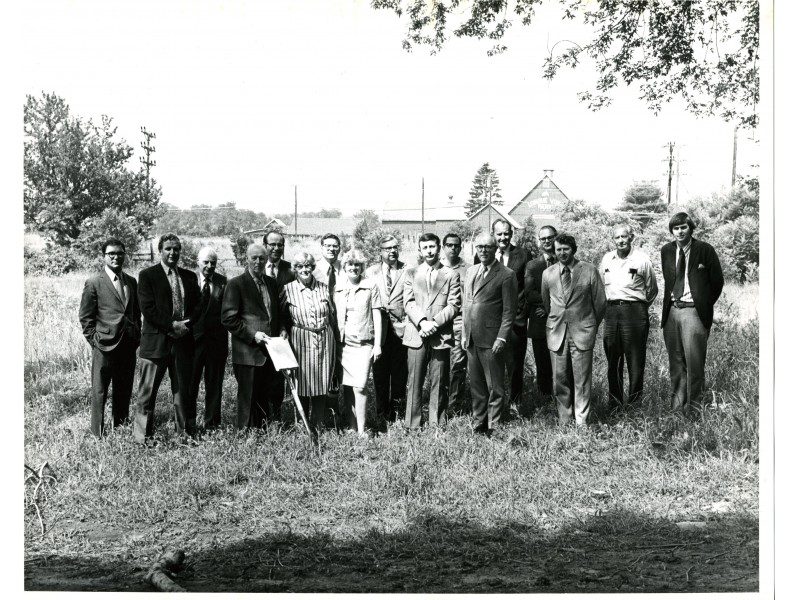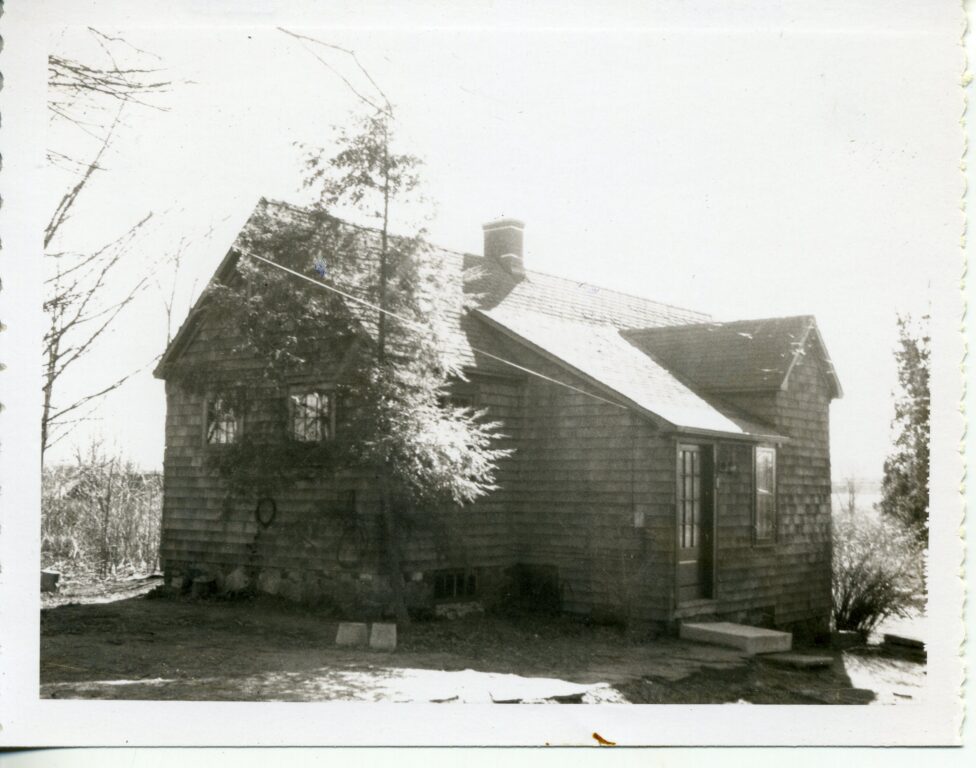From the West Hartford Archives: Wolcott Park

Audio By Carbonatix

Groundbreaking ceremony for Wolcott Park on July 7, 1972. Photo courtesy of Noah Webster House & West Hartford Historical Society
Historian Jeff Murray takes a look into West Hartford’s past to uncover some surprising information, stir up some memories, or reflect on how much life has changed – or hasn’t changed at all. Enjoy this week’s ‘From West Hartford’s Archives’ …
By Jeff Murray
This photograph was taken at the groundbreaking ceremony for Wolcott Park on July 7, 1972. Standing fourth and fifth from left are Henry F. Wolcott and his sister Ruth Wolcott, who had sold the land to the town two decades prior.
Wolcott Park’s history can be traced back to the Francis family, who occupied the land on the south side of New Britain Avenue for nearly a century. Roger Francis was born in Wethersfield in 1763 and eventually moved to West Hartford, where his son Chester grew up.
Chester served as a deacon in the Congregational Church and signed his name to the petition in 1854 for independence from Hartford. His son Samuel owned the farm after the Civil War and through the latter half of the 1800s. He was involved in the operations of the Elmwood school district and the choir of the Congregational Church. In 1899, he sold the entire farm to the Long Brothers, who managed a hotel and restaurant in Hartford. They sought a place out in the country where they could utilize the food waste. Three thousand meals were served at the Long Brothers’ restaurant daily. They raised poultry and pigs mainly, the latter fed by the food scraps from their business (vegetable peels, stale bread, etc.). To give an idea of scale, the firm bought 125 pigs for the farm in the spring of 1900.
At the time of the purchase, the Francis farm was considered an eyesore. The Hartford Courant visited the farm in 1899 and noted that gravel for road paving had been dumped right to the farmhouse. The land was overgrown by weeds and bush and the pasture had been “sapped.”
The Longs kept the pigs in a grove far back from the roadway (where Wolcott School is now). They would cart the food scraps in open wagons, which was against health rules in West Hartford. They argued this rule constantly with the health officer Frank Stadtmueller, who managed the Beach family’s Vine Hill Farm right down the road. A settlement was reached where they could continue to cart the garbage to the farm, but only between 8 p.m. and 8 a.m., and once the pigs were fattened up, they would end the business entirely. In November 1900, despite warnings, the Longs continued the business (as noted by an undercover West Hartford constable who followed the wagon from Hartford). Stadtmueller jumped in again and tried to rally the people against the carting business as a public “nuisance,” but the Courant visited the farm for a second time and reported that the land had been so greatly improved since the Longs took over. There was extensive growth of cabbage, hay, millet, and corn. Nearly half a mile back from the road were the pigs in the edge of a dense wood containing lots separated by board fences and hidden from view.
The negative coverage died down soon after that, but the Longs sold the 50-acre farm to Dr. Leslie Chapman in September 1902 anyway. Maybe they just had enough of the press.
Dr. Chapman was a dentist on Pratt Street in Hartford, who overhauled and refit the house for just about five years when he finally sold it to Henry A. Wolcott in the summer of 1907. Wolcott was an engineer by trade and demonstrated improvements in potato yields using machinery that fall.
Wolcott was especially active in West Hartford history. He was elected a selectman in town from 1909 to 1911, pushed for trolley extensions from Elmwood to Corbin’s Corner in 1912 (although this did not happen), and oversaw the construction of the Seymour Avenue School (Smith School) in 1914. He designed the Jewell Belting Company factory on New Park Avenue and the Hartford Tube Products Company plant near Newington Road in 1919 (this building still exists off Brook Street). Wolcott was also the treasurer of the Elmwood Community Church in the 1920s (and you can bet he was on the building committee when it was built starting in 1926). He served on the zoning commission, the school board, and the finance board. He lived at the farmhouse (which he had built onto in the 1910s) at 1341 New Britain Avenue with his wife Susan, three sons, Henry, Richard, and Lawrence, and his daughter Ruth, until his death in 1941.

The Wolcott house at 1341 New Britain Avenue. Photo courtesy of Noah Webster House & West Hartford Historical Society
The Wolcotts operated a vegetable stand on New Britain Avenue, not far from the Gerths’s Long Vue Farm west of Chatfield Drive. In 1950, the widow Susan lived at the farmhouse with son Richard and daughter Ruth. Her other son, Henry F. Wolcott, lived with his wife and children in a smaller, more rustic house in the rear, set back from the road.
In the spring of 1953, the Wolcott family sold off the 50-acre farm to the Town of West Hartford for use as a school and park. In May 1954, the land was targeted for an elementary school (at first, it was considered for a southern high school, although Conard High School won out there). It was named after Wolcott for his work on the school board for a decade and for his engineering work on a number of new schools in the 1920s, a critical time for education facilities. The school head said in the 1950s during the naming that Wolcott “had envisioned a time when a school would be on his farm.”
After selling off the land to the town, the Wolcotts retained lifetime use of the houses. However, they continued using some of the town-owned land to raise vegetables, which was promptly reported to them by their neighbors, the Gerths. In 1957, the town manager had to step in and instruct them to stop.

The second Wolcott house in the rear of the first one, occupied by Henry A. Wolcott’s son Henry F. Wolcott and family. Photo courtesy of Noah Webster House & West Hartford Historical Society
Plans for the future Wolcott Park came into vision in the 1960s. In the summer of 1962, the Allen Organization of Bennington, Vermont conducted an extensive survey of West Hartford under a grant from the Hartford Foundation for Public Giving. They submitted numerous recommendations for new parks throughout the town; some of them came to fruition, like Spicebush Swamp. They submitted plans to the town council for a park on the former Wolcott farm and offered a vision for the facilities: volleyball, tennis, and badminton courts; shuffleboard; a garden center with greenhouse; town nursery; use of the Wolcott Pond for ice skating; parking near Elmfield Street; a swimming center; a picnic center in the wooded area near the pond; and trails.
The State of Connecticut requested a fifth of the land in 1963 for use in the construction of I-84, but it didn’t take away from the plans for Wolcott Park. What delayed the park was mostly legal and some politics. Under the terms of the sale of the land by the Wolcotts, the land had to be left undeveloped until the life use of the family ended. Until then, Wolcott Park was simply the product of daydreaming. The 1962 survey recommendations were promptly tabled. It came up again in 1966 when the park land was considered for an artificial ice rink (it would be built soon after at Buena Vista). A baseball diamond was proposed in 1967 and $25,000 was set aside for park planning, but nothing had been accomplished by the end of 1968.
Preparatory work finally began in the summer of 1969 on Wolcott Park. The former Mayor Sheehan called for the park to be named the Veterans’ Memorial Park in honor of West Hartford boys killed in Vietnam, but the name was better suited for other locations in town. Ernest St. Jacques, superintendent of parks, was appointed director of Parks and Recreation in 1970 and immediately set out to demolish the barns, sheds, and chicken coops that had been on the Wolcott farm in preparation for park construction. He said on April 22, 1970: “There are also two houses on the property, both of which were vandalized during the winter.”
By the late 1960s, the widow Susan Wolcott had moved away. She died on Feb. 12, 1971 at the age of 99 and the life use of the property ended. Work then proceeded quickly. Bids went out for construction in May 1972 and the architects, Johnson and Dee Landscape Architects of Avon, won the best design, which managed to win a national award! Most of the natural vegetation was kept, as well as a swampy area of the park for nature-study purposes. On the day of the groundbreaking ceremony, Henry F. Wolcott and his sister Ruth made it to the park.
Wolcott Park was formally dedicated on July 12, 1973 and was the only park in West Hartford with lights. The park saw many improvements in the 1990s and within the last decade. The development of the Wolcott Children’s Forest helped bring it to its full potential (and as a graduate of Wolcott in 2005, I have fond memories of the grounds).
It has been half a century since Wolcott Park was dedicated, but its story provides a perfect example of how the community can repurpose a family farm. Over time, some of our landmarks will go away and our neighborhoods will change. They can be replaced with something just as good (and maybe even better).

Pickleball courts at Wolcott Park in West Hartford. Photo credit: Ronni Newton (we-ha.com file photo)
Jeff Murray was born and raised in West Hartford and has been involved with the Noah Webster House & West Hartford Historical Society since 2011 when he was a high school student and won the Meyer Prize for his essay on local history. Jeff routinely volunteers as local history researcher uncovering information for numerous museum programs such as the West Hartford House Tour and West Hartford Hauntings. Jeff works as a data analyst at Pratt & Whitney.
Like what you see here? Click here to subscribe to We-Ha’s newsletter so you’ll always be in the know about what’s happening in West Hartford! Click the blue button below to become a supporter of We-Ha.com and our efforts to continue producing quality journalism.




Grew up on Huckleberry lane in the 60’s, the whole area in this story was the playground for all of the kids in the neighborhood. OH the story’s we could tell. Enjoyed the read didn’t know of all the history behind it. Thanks.
The park was designed like the spokes of a wheel. Between the spokes were, tennis courts baseball field, and an open field for football soccer or rugby. It was great for sledding in the winter.
Donald, I appreciate your comments about the Wolcott area. I was a friend of David Sanko, who lived on Huckleberry, and I knew Bob Cyrulik through Dave. My guess is that you’re Bob’s brother. I’ve long wondered about the history of the Wolcott area. I attended Wolcott school from kindergarten through the second grade and my teachers were Mrs Slade, Miss Fernhaber, and Miss Haines. You may recall the names. I remember skating at Wolcott pond when I was very small. I guess it became the swamp that’s now part of the park. Glad you commented; it helped bring back some memories.